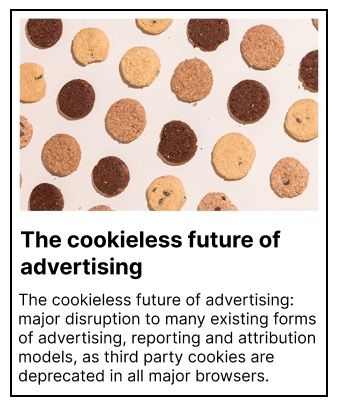The rallying cry around a privacy-first internet – one where our personal information and behaviours are kept private – is a backlash against Big Data’s over-extended reach. But we believe it is more than that: we see it as the path back to relevance for our industry.
This emphasis on privacy and the intentional act of putting the customer at the heart of every activity is the driving force behind how we help our clients do marketing and advertising.
We have set out three key pillars to help brands navigate this shift, which we’ll explore in more detail below. But first, let’s take a closer look at the root of the problem.
A decline in consumer trust

81% of people say the risks of brands collecting their personal data outweigh the benefits, according to the Pew Research Center.
More than half of the world’s population is now online, a milestone we passed in late 2018. And while this has been empowering for many – providing access to essential information, connecting people and ideas across distances – it has also contributed to deepening societal divisions, misinformation and overreaching surveillance.
There is a saying that the road to hell is paved with good intentions, and for many people, the digital landscape where we live so much of our lives feels more like a dystopia than the ‘open and democratic platform for all’ envisioned by Sir Tim Berners-Lee, the creator of the world wide web.
Marketers occupy a unique place in this landscape. We are the face of the companies we work for and with to the general public. But we are also the reflection of the customer back to the company – gauging changes in preference and behaviour, listening for signals in their actions.
And what people are telling us isn’t great.
- A 2019 report from the Ad Association showed that – in terms of public trust – the advertising industry is at the bottom of the list of industries people trust
- Research from Kantar reports that advertising is seen as annoying noise, with only 15% of people saying they enjoy ads down from 30% enjoyment 30 years ago
- 18 months after GDPR launched, ‘there have been 200,000 court cases involving companies that have failed to safeguard user data‘
The perfect storm
We’re in the midst of two major technological changes that are set to have an immediate impact on the advertising industry as we know it.


How did we get here?

With few exceptions, we as an industry have conflated digital activity with actual marketing.
We lost sight of the essentially human act of connecting people with needs to the companies with the products and services that meet those needs.
We allowed the promise of an algorithm delivering our content to the target audience to let us off the hook of doing the hard work of creating compelling campaigns that people would actually want to watch.
Below is a brief history of online advertising.
1960s–1980s: The Golden Age of Advertising
Early 1990s: The Birth of the Internet & Online Ads
1994 & 1995: The Invention of the Cookie and the Internet Advertising Network
Late 1990s: The Beginning of Data Legislation in Europe
As an initial response to the use of personal and browsing data, the EU announced their Data Protection Directive in 1995, although it wasn’t implemented until 1998. In the US, a blanket ruling to deal with data protection was ignored in favour of a fragmented state-to-state, industry-to-industry regulation.
Early 2000s: Growth of Search Engines, Social Media & Online Advertising
2009: When Internet Advertising overtook TV Advertising
2010s: Dominance of Google and Crackdown on Data
Privacy
Mid-2010s: Focus on Website Security
2017: Blocks on Third Party Cookies
2018: The Implementation of GDPR
Late 2010s: Facebook Scandals
2021: The ePrivacy Regulation
2021: Apple’s iOS 14 Update
2021: Google’s Announcements on Cookies & a Privacy-First Future
And so here we are, poised on the edge of disruption, and the choice is ours.
Will we see this move toward a privacy-first internet as a blow for the marketing status quo or will we rise to the challenge of delivering true value for customers and profits for the business in a way that respects privacy?
Here’s how we’re helping our clients take the latter approach.
Delivering Exceptional Experience
To regain trust and earn attention in a fragmented marketplace, every interaction with the brand needs to deliver an exceptional experience.
- Ensure all your messaging and activity is relevant and delivers value through customer-centric strategies
- Capture attention and engage customers with creative campaigns and brand-led experiences
- Apply a test-and-learn approach to deliver measurable results for the brand (e.g. CRO)
Using Curated Data
Understanding how customers see, interact with and take action from your campaigns will rely on a robust first-party data strategy – a pursuit you should start straight away.
- Ensure data is collected with clear consent and stored in a way that protects people’s privacy and complies with country-specific regulations
- Use first-party and partner data to connect with customers in a way that delivers value and maintains their privacy
- Update reporting and integrate data sources using customer data platforms to ensure critical business decisions are still grounded in customer insight
Guiding Strategic Transformation
Navigating and adapting to the new privacy-first media landscape will take the right combination of technology, skills and leadership to succeed.
- Understand the current state of your brand’s data management strategy and identify clear objectives for improvement
- Deliver step-by-step guidance of the martech transformation required within the business to support privacy-first customer interactions
- Upskill your in-house team to use first-party data in practical ways to deliver better results
Use your time wisely

Now is the moment to return to the central tenets of marketing and use the data the digital landscape produces to connect with customers as people, not metrics on a spreadsheet. And to do so in a way that respects their privacy.
As the landscape continues to reshape itself over the coming months, we’ll be returning to these topics to help guide you in your response. A few of our recent articles are below.
And do contact us for bespoke recommendations and advice on how to adapt your approach for a privacy-first future.









